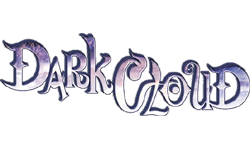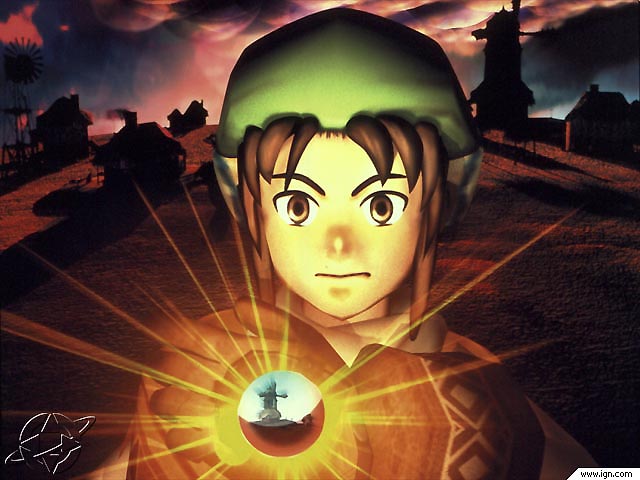|
|

|
PLATFORM
|
PS2
|
BATTLE SYSTEM
|

|
INTERACTION
|

|
ORIGINALITY
|

|
STORY
|

|
MUSIC & SOUND
|

|
VISUALS
|

|
CHALLENGE
|
Moderate
|
COMPLETION TIME
|
20-40 Hours
|
|
OVERALL

|
+ Fun weapon system.
+ Decent simulation aspect.
+ Nice visuals.
- Random dungeons can be repetitive.
- Weak story.
- Bland battle music.
|
Click here for scoring definitions
|
|
|
A group of militants from an eastern continent revives an ancient evil known as the Dark Genie, which their leader wishes to use for world conquest. The Dark Genie first attacks Norune Village, although the Fairy King casts a protective spell on the town and the rest of the world, sealing all buildings, people, and so forth into floating orbs known as Atla. The only boy spared from this is Toan, whom the Fairy King gives a blue stone called the Atlamillia, allowing him to unseal the Atla, rebuild the world, and possibly stand a chance against the Dark Genie. Dark Cloud, developed by Level-5 and published by Sony, was one of the first RPGs for the Playstation 2, combining action RPG and simulation elements into a reasonably-fulfilling quest.
Gameplay in Dark Cloud is fairly methodical, with two primary modes: dungeon exploration and simulation. Each area to rebuild has a dungeon with a certain number of floors Toan must traverse, and where he can unseal Atla to obtain building parts and people necessary for rebuilding. As the player places buildings on the simulation fields and adds parts and people to them, their residents buildings will make requests on how to rebuild their homes, where to place them, and so forth. After completing one building, a special event will occur, with Toan typically gaining an item, and other items regularly appearing in and around these buildings, some of which will increase the HP, defense, and thirst stats for each playable character.
Each floor of the dungeons themselves is randomly-generated, with a number of enemies wandering about for Toan and his five acquirable allies to battle, one of which holds the key to the next floor. Countless treasure chests litter each floor, with two of them holding a map of the current floor and an orb showing the locations of chests and enemies. Some treasure chests, small and large, might actually be enemies in disguise, while some of the large chests are trapped yet hold better treasure, with Treasure Keys being necessary to disarm said traps, although the player can still guess the trap to open them, with traps including HP-depleting poison, a damaging explosion, or a curse preventing the current character from changing his or her weapon.
 A Link, er, Toan, to the past
A Link, er, Toan, to the past
|
|
Battles in dungeons begin whenever the active character approaches them and the music changes, in which case the player can use the lock-on option to fix the camera on them and either hack or shoot away at them, depending upon whether the active character's weapons are melee or ranged. Most characters have a special charge command that's typically better than their normal attacks, although using them will more quickly wear down a Weapon's Hit Points. Here, the player must be especially carefully, since completely depleting WHP will cause the weapon to break. Thus, the player must keep plenty of Repair Powders to regularly refill WHP.
Whenever a character defeats an enemy, the equipped weapon's Absorption will increase. Once the weapon's Absorption bar has completely filled, the player can upgrade that weapon, with a number of slots allowing for various types of attachment gems impacting things such as attack power, elemental affinity (with the player able to change a weapon's element in the menus as long as it has at least one point of certain elements), and effectiveness against certain kinds of enemies. Once the player has put in whatever attachments are desired, the player can upgrade the weapon (though upgrades are possible without attachments, doing so isn't a good idea), in which case the attachments' bonuses become a permanent part of the weapon.
The process of killing enemies to fill a weapon's absorption bar repeats after weapon upgrades, and once a weapon has been upgraded a certain number of times, the player can seal 60% of that weapon's power in an attachment gem to use on another weapon. It is possible, moreover, to upgrade weapons to more powerful forms after increasing the required stats, and upgrade those more powerful forms to even more powerful forms, and so on. Helping in these weapon-building endeavors is that each dungeon floor has a "back room," accessible with certain types of items, which typically have more powerful types of gems, along with morepowerful enemies.
 Sephiroth gets a haircut
Sephiroth gets a haircut
|
|
There are other factors to consider in dungeons, such as the need to use specific characters to get past certain obstacles and each character's thirst meter, which gradually depletes during exploration, and damages a character's HP when empty. Water, whether from consumable bottles or fountains in dungeons, refills each character's thirst meter. There are also many dungeon floors where the player can only use one character, defeating enemies reduces Absorption, and thirst depletes faster. Moreover, there are certain floors where the player must fight "duels," which are simplistic and require the player to press a certain sequence of buttons, and boss battles that require some semblance of strategy.
Building weapons is perhaps the best part of combat in Dark Cloud, given the many characters and variety, and while the possibility of losing them to weapon breakage can loom large, it actually isn't quite common as long as players remember that they can indeed break. The thirst system will certainly annoy some, as well, although once the player has increased each character's thirst gauge enough, it becomes a trivial annoyance at best. A character's death results in the game asking the player to use a Stand-In Powder to switch to another character or pay half his/her money to leave the dungeon. The only major problems with the battle system are the camera, given the inability of players to get an overhead view of the battlefield, the lack of shortcuts for changing magical elements, and the lack of a Game Over option for death in battle, since bosses can really tax the player's resources. Still, combat is fairly solid.
Interaction is adequate, with relatively easy menus and controls, although some will find the dungeons to be somewhat repetitive, and since the game loves to shower players with mini-treasure-chests as they rebuild towns, it might have been nice if the game indicated which buildings had these chests instead of forcing the player to constantly check around for them. Given the endless variety of items, moreover, one-stop shopping would have been nice, since sometimes it can be easy to forget where shops are in towns and which sell what. The player's inventory space can also fill up somewhat quickly at times, given the lack of stackable items, and a scene skip option would've been nice, as well. All in all, interaction isn't a terrible deterrent, but could have been more streamlined.
 Unsealing an Atla
Unsealing an Atla
|
|
Dark Cloud's hybrid of dungeon exploration and action combat with simulation isn't a first for RPGs, with ActRaiser featuring a similar combination. The weapon system, with its endless array of stats, such as certain effectiveness against various types of enemies, and gem attachments, is also reminiscent of that in Vagrant Story, aside from the ability to level up said weapons. The story of fighting a resurrected ancient evil and rebuilding the world doesn't show much creativity, either, and overall, the first Dark Cloud is at best a derivative title.
The story is easily Dark Cloud's weakest link. Toan is essentially a random nobody given the generic task of saving the world, and while a few of his allies do have some sort of story behind them, there is very little, if any, interaction among Toan (who is, by the way, a silent protagonist) and his allies, with most of the plot unfolding through conversations with NPCs after completing their buildings in each town, and the narrative itself consisting mostly of backstory, which is actually half-decent. The translation is with its flaws, as well, such as a few name inconsistencies (for instance, "Muska Lacka" and "Muska Racka"), and ultimately, the plot is hardly a reason to play the game.
The soundtrack has some decent tracks, such as the Wise Owl Forest theme, although its presentation leaves something to desire, what with the lack of music at night, and that perhaps the weakest track in the game, the battle theme, is the most common track. Sound is adequate, with believable sound effects and voice clips mercifully limited to grunts during battle. All in all, the game's aurals are by no means a deterrent, although some presentation issues with the music do leave something to desire.
Though one of the first Playstation 2 RPGs, Dark Cloud features a decent visual style that's neither fully realistic nor fully anime-like, with believable scenery, colors, character models, and monster designs, even if many are palette swaps. The first installment was supposedly to have cel-shading much like future Level-5 titles, although Sony's desire to make it one of the PS2's first titles hastened its development. Even so, the visuals are far from bad, and one of the game's high points.
Finally, Level-5's first title is about a thirty-hour game, with a post-game dungeon adding plenty of supplementary playing time. Overall, Dark Cloud was a decent start for Level-5, given its share of enjoyable aspects such as its battle system, the simulation, and its visuals, although it does have much going against it, such as its weak story and flawed aural presentation. Still, one could consider the game to be something of a spiritual successor to ActRaiser, given its similar fusion of action elements and simulation, and while it could have certainly been better, it was nonetheless a half-decent step in the right direction for Playstation 2 RPGs.
Review Archives
|









